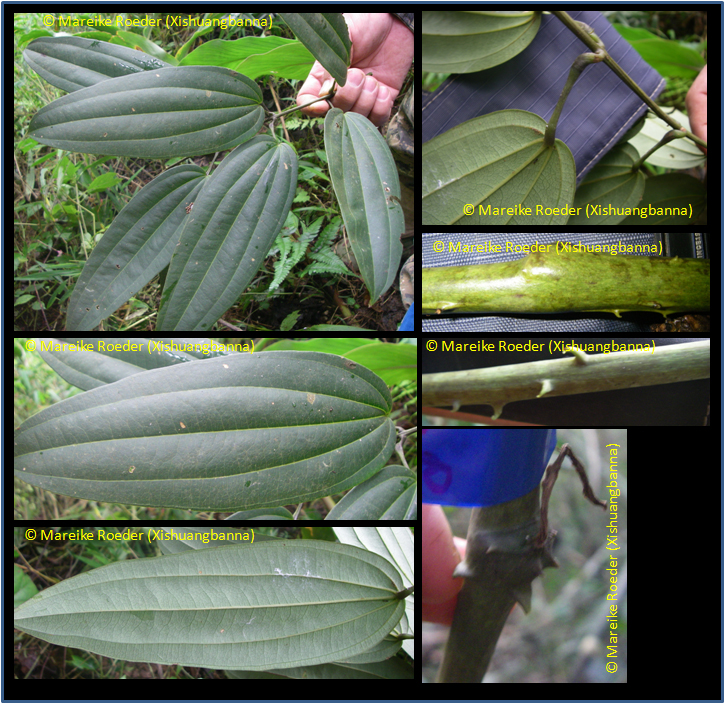Dioscorea cirrhosa Lour., Fl. Cochinch. 625 (1790)
Species name meaning 'curly', referring to its climbing stem.Synonyms
Dioscorea angusta R.Knuth
Dioscorea bonnetii A.Chev.
Dioscorea camphorifolia Uline ex R.Knuth
Dioscorea cirrhosa var. cirrhosa
Dioscorea cirrhosa var. cylindrica C.T.Ting & M.C.Chang
Dioscorea intempestiva Prain & Burkill
Dioscorea matsudae Hayata
Dioscorea rhipogonoides Oliv.
Strophis cirrhosa (Lour.) Salisb.
Description
Liana. Tubers globose, ovoid, gourd-shaped, oblong, or cylindric; cork dark brown; transverse section
light brown or red, drying purplish black. Stem twining to right, branched, green, to 20 m, glabrous,
prickly at base. Leaves alternate basally on stem, opposite distally on stem, simple; petiole 2-6 cm;
leaf blade adaxially dark green, abaxially whitish, ovate to linear, 5-20 x 0.6-14 cm, leathery or
subleathery, glabrous, basal veins 3 or 5, reticulate veins prominent, base rounded, sometimes triangular
lobed, margin entire, apex acute or acuminate. Male spikes 2-10 cm, in axillary panicles 2-14 cm or longer;
rachis straight. Male flowers: outer perianth lobes ovate or broadly so, ca. 2 mm, inner ones obovate;
stamens 6, slightly shorter than perianth lobes. Female spike solitary, to 12 cm. Capsule not reflexed,
oblate, 1.8-3.5 cm, base emarginate, attenuate into pedicel ca. 7 mm, apex emarginate; wings 1.2-2.7 cm
wide. Seeds inserted near middle of capsule, 1.8-2.4 cm in diam. (ca. 0.6 cm excluding wing), winged all
round. [from Flora of China]
Ecology
Mixed forests, broad-leaved forests, scrub forests, mountain slopes, valleys, along rivers, roadsides;
near sea level to 1500 m. It is sometimes not clear whether plants are truly wild or have escaped from
cultivation and naturalized, as is often the case with other Dioscorea species.
Uses
The tubers have a very high tannin content and are used to dye and preserve fabrics. The tuber is edible.
The tubers contain 6-13% tannin. This is used for preserving nets and leather as well as for colouring
clothes made from ramie, silk and cotton a brown colour. The tubers are harvested when about 3 years old,
the harvesting taking place in the dry season when the red flesh has a high tannin content. The tubers
should be harvested with care to ensure that they are not broken or bruised. They should be protected
against desiccation because they lose much of their colouring properties when desiccated. For dyeing and
tanning purposes, the tuber are peeled and the flesh is rasped. About 3 litres of water is added to 1 kg
of rasped flesh, and clothes or nets are dipped in the hot or cold solution remaining after filtering, and
afterwards dried in the sun. This handling is repeated several times, until the desired reddish-brown
colour is attained. The dye rapidly loses its activity, and best results are obtained with fresh
solutions. Mordants such as alum, aluminium acetate and bichromate are often added to the solution, but
sometimes leaves of Psidium guajava L. and Piper betle L., or mud (in China) replace the
mordant. At the beginning of the 20th Century, dye-yam was an important product for export from northern
Vietnam, with a maximum shipping to Hong Kong of 8000 t/year. Since 1930 exports have rapidly diminished.
The main reason for this decline is undoubtedly the increasing use of synthetic dyes, but excessive
exploitation of the wild populations of this species may also have caused the market to decline, as
happened at the end of the 19th Century in Hong Kong. At present, dye-yam is only of local importance.
Distribution
From southern China and Taiwan into Indochina. Dye-yam is a native of north-eastern Thailand, Laos,
Vietnam, south-eastern China (Provinces Guangxi and Guangdong), Hong Kong, Taiwan, and the southern
Ryukyu Islands. Throughout this area it is sometimes also cultivated.
Local names
China: Shu liang.
English: Dyeing Yam, Dye root.
French: Faux gambier.
Laos: thoom l¨šad, kabau, houa.
Vietnam: cu'nau (general), khoai leng (central).
